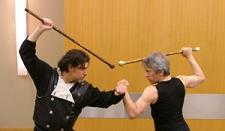|
Bartitsu is an eclectic
martial art and self-defense method originally developed in England during
the years 1898–1902. In 1901 it was immortalised by Sir Arthur Conan Doyle,
author of the Sherlock Holmes mystery stories. Although dormant throughout
most of the 20th Century, Bartitsu has been experiencing a revival since
2002 |
 |
|
Bartitsu was largely
drawn from the Shinden Fudo school of koryū ("classical") jujutsu and from
Kodokan judo, both of which he had studied while resident in Japan. As it
became established in London, the art expanded to incorporate combat
techniques from Tenjin Shinyō, Fusen and Daito Ryu schools of jujutsu as
well as British boxing, Swiss schwingen, French savate, and a defensive la
canne (stick fighting) style that had been developed by Pierre Vigny of
Switzerland. Bartitsu also included a comprehensive physical culture
training system.
Bartitsu might have
been completely forgotten if not for a chance mention by Sir Arthur Conan
Doyle in one of his Sherlock Holmes mystery stories. By the 1890s, Conan
Doyle had become weary of chronicling the adventures of Sherlock Holmes. He
had actually killed Holmes off in his 1893 story, The Adventure of the Final
Problem, in which Holmes apparently plunged to his death over a waterfall
during a struggle with his arch-enemy, Professor Moriarty.
However, such was the public clamour for the fictional detective’s return
that Conan Doyle capitulated and revived Holmes for another story, The
Adventure of the Empty House, in 1901. As Holmes himself explained his
apparently miraculous survival:
When I reached the end I stood at bay. He drew no weapon, but he rushed at
me and threw his long arms around me. He knew that his own game was up, and
was only anxious to revenge himself upon me. We tottered together upon the
brink of the fall. I have some knowledge, however, of baritsu, or the
Japanese system of wrestling, which has more than once been very useful to
me. I slipped through his grip, and he with a horrible scream kicked madly
for a few seconds and clawed the air with both his hands. But for all his
efforts he could not get his balance, and over he went. With my face over
the brink I saw him fall for a long way. Then he struck a rock, bounced off,
and splashed into the water. |













